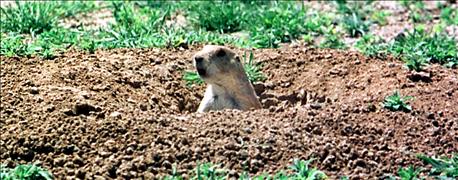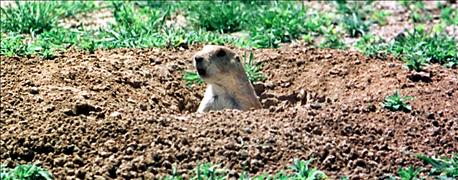December 12, 2016

Rangeland with prairie dog populations will produce less grass for cattle, accounting for a significant decrease in weight gain. "Increased colonization causes more detriment to the pasture, and can result in a 5.5% to 14% decrease in cattle weight gains," Jenna Meeks tells producers. For a 500-pound steer, this can account for a loss of 27 to 70 pounds per calf. At $1.35 a pound, that is $36 to $95 less revenue per head.

A NECESSARY EXPENSE: Prairie dog control can be a costly expense, but a necessary one, says Jenna Meeks, with the Goshen County Weed and Pest Department in Torrington, Wyo. "It is important to access the situation and make a management plan. A few prairie dogs can get out of control in a hurry," she says. (Copyright Michael Smith, Getty Images)
Meeks, who works with the Goshen County Weed and Pest Department in Torrington, Wyo., says cattle will gain 6% more weight grazing in areas without prairie dogs. "Increased colonization areas cause less gain per head and less gain per acre," she explains. "In these areas, vegetative recovery can take up to 20 years depending upon weed pressure, precipitation and wind erosion."
Prairie dogs typically mate between February and March, with pups born between April and May. Although the average litter is usually three to four pups, it can be as high as eight, she says. The prairie dog life span is three to five years, but half the pups will die in the first year due to predation, disease and lack of food, she explains. "It is impressive they can expand as fast as they do, given that half the litter will die."
Prairie dogs prefer short-grass prairie, and favor grama grass, western wheat grass and buffalo grass, although they will eat cactus, thistle roots and seed during the winter. Meeks says they can get the water they need to survive during the winter from the plants they consume.
Prairie dogs prefer low-biomass areas. Producers can create visual barriers using vinyl or other material, tallgrass barriers and cultivation, as well as irrigation to repel prairie dogs. "Be proactive about prairie dog control," Meeks says. Fall is an ideal time to focus on prairie dog control. Producers can consider leveling and eradicating mounds, preventing overgrazing, reseeding areas, and moving watering sites from the short-grass areas they prefer.
Producers can also choose to hunt or trap prairie dogs, but the most effective methods are toxicants or fumigants. Bait like Kaput or Rozol can be dropped into their burrows, and will cause death by hematoma. "They are considered anticoagulants, so the capillaries will rupture," Meeks explains.
She encourages producers to look at the EPA website before using any anticoagulants for prairie dog bait. Some states require applicants to carry a piece of paper that can be printed out from the EPA website, showing they read the regulations.
Livestock cannot be grazed on treated areas for 14 days. "If you check the areas baited, and don't see any bait on the surface of the ground, then you can graze," she says. "If you do find bait on the surface, you need to put it back down into the burrow and wait another 14 days."
Another method of control that has been used successfully is poisoning prairie dogs with poisonous oats. Meeks recommends placing a teaspoon of the poison on the edge of the mound in the morning. When prairie dogs consume it, the poison reacts with the moisture and stomach acids causing death by asphyxia.
Prairie dog control can be a costly expense, but a necessary one, Meeks says. "It is important to access the situation and make a management plan. A few prairie dogs can get out of control in a hurry."
Commercial costs per acre to treat with Kaput or Rozol are an estimated at $19.50 per acre. Bait costs vary depending upon severity but can cost at least $6 an acre. Poisonous oats can cost $22 to $24 an acre, with a bait cost of at least $3 an acre. A good rule of thumb is $20 to $30 an acre, depending upon bait and density, Meeks says.
Clark writes from Potter.
You May Also Like




